
Browse an alphabetical list of photographs. These historical images portray people, places, and events before, during, and after World War II and the Holocaust.
<< Previous | Displaying results 851-900 of 2641 for "Photo" | Next >>
Postcard showing Evian-les-Bains, a French resort of Evian on Lake Geneva, at the time of the 1938 Evian conference on refugees.
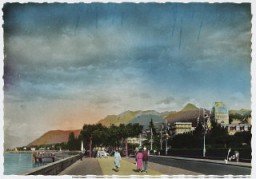
Photographs, artifacts, and a map presented as evidence at the International Military Tribunal. Nuremberg, Germany, between November 20, 1945, and October 1, 1946.
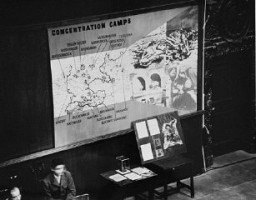
In German-occupied Paris, the fence around a children's public playground bears a sign forbidding entrance to Jews. Paris, France, November 1942.
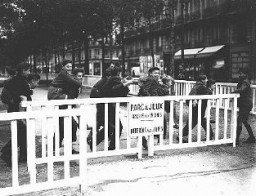
Execution of prisoners, most of them Jewish, in the forest near Buchenwald concentration camp. Germany, 1942 or 1943.
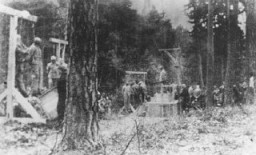
A Romanian firing squad prepares to execute former Romanian prime minister Ion Antonescu. Camp Jivava, near Bucharest, Romania, June 1, 1946.

Arrow Cross Party members execute Jews along the banks of the Danube River. Budapest, Hungary, 1944.
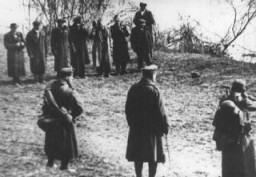
The execution of Poles in the Barbarka Forest by members of the Selbstschutz (ethnic German self-defense organization). An SS officer can be seen standing in the background. Torun, Bydgoszcz, Poland, October 1939.
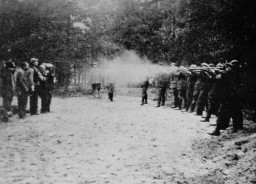
German police execute a group of Poles at the edge of the Uzbornia Grove just outside of Bochnia. Altogether, 51 residents of Bochnia and the vicinity were shot in reprisal for an assault on a German police station by members of the Polish underground organization "Orzel Bialy" (White Eagle) on 16 December 1939. Bochnia, Krakow, Poland, December 18, 1939.
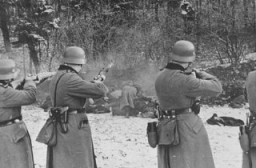
The execution of Polish civilians by the Selbstschutz (ethnic German self-defense organization) and SS in the forest near Tuchola. Bydgoszcz, October 27, 1939.
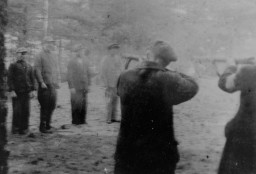
Execution of Polish prisoners of war near Ciepielow in September 1939. Some of the 300 Polish POWs who were executed here by firing squad are visible. In the background is a Wehrmacht soldier who participated. Ciepielow, Radom, Poland, September 1939.

Teachers from Bydgoszcz and the surrounding area a few moments before their execution by firing squad in the "Valley of Death" near Fordon. The first in line is Wladyslaw Bielinski, a primary school teacher from Wiag. The Nazis sought to destroy Polish culture and the Polish nation, and eliminate any resistance, by arresting and murdering Poles. German police, SS, and army units and ethnic German “self-defense” forces shot thousands of Polish civilians. Among those shot were wealthy landowners, some…
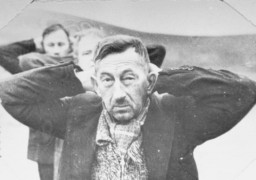
Arrow Cross Party members execute Jews along the banks of the Danube River. Budapest, Hungary, 1944.
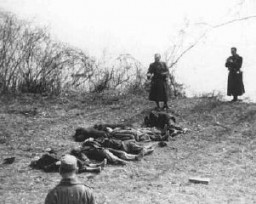
Execution site at the Ploetzensee prison. At Ploetzensee, the Nazis executed hundreds of Germans for opposition to Hitler, including many of the participants in the July 20, 1944, plot to kill Hitler. Berlin, Germany, postwar.
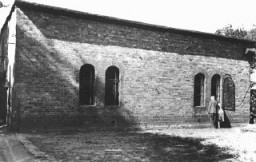
Execution site in the Flossenbürg concentration camp, seen here after liberation of the camp by US armed forces. Flossenbürg, Germany, after May 1945.
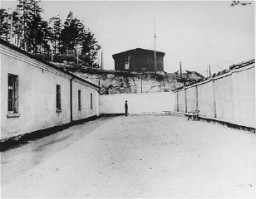
Execution site in the Ponary forest outside the Vilna ghetto. Lithuania, 1941.
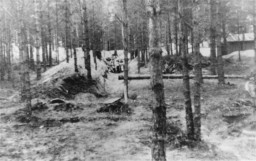
An exhibition at the United States Holocaust Memorial Museum demonstrated how the Nazis used the Protocols of the Elders of Zion to spread hatred of Jews. Washington, D.C., 2006-2018.
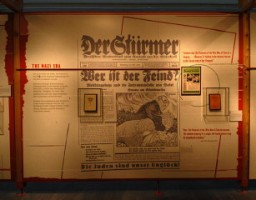
US troops with the 82nd Airborne Division look on as Germans are forced to exhume corpses from a mass grave. Wöbbelin, Germany, May 6, 1945.
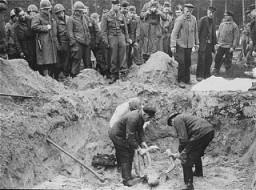
New York Herald reporter Herman Bernstein declared the Protocols “a cruel and terrible lie invented for the purpose of defaming the entire Jewish people.” Published in New York, 1921, reprinted 1928.
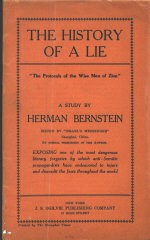
German soldiers expel Polish inhabitants from the Zamosc area. Poland, 1942-1943.
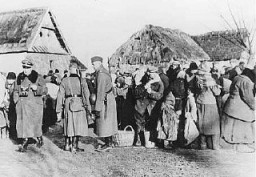
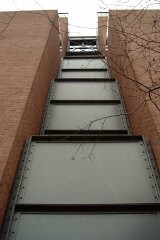
Entrance to a factory built into the side of a hill at the Natzweiler concentration camp. 1945.
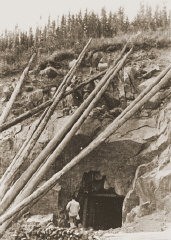
False identification card photo of Benjamin Miedzyrzecki (Benjamin Meed) as a member of the Warsaw ghetto underground. Warsaw, Poland, 1943.
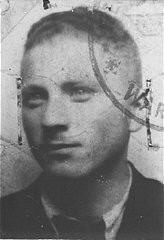
False identification card which Vladka Meed had used from 1940–42 on the Aryan side of Warsaw, smuggling arms to Jewish fighters and helping Jews escape from the ghetto.
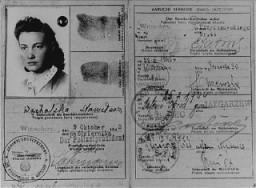
Celebration after one of Regina's sons, Harry, received the Eagle Scout Award. February 16, 1973.
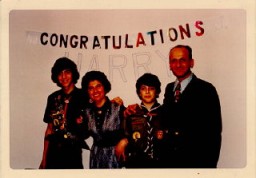
Family members say goodbye to a child through a fence at the ghetto's central prison where children, the sick, and the elderly were held before deportation to Chelmno during the "Gehsperre" action. Lodz, Poland, September 1942.
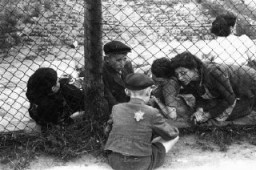
Szyja Faktor, his wife Sala, and their daughter Frieda pose for a photograph while living in the Rivoli displaced persons (DP) camp in Italy, circa 1947–1948. During the war, Szyja, a Polish citizen, had briefly been held by the Germans. He escaped to the Soviet Union, where he stayed until 1945.
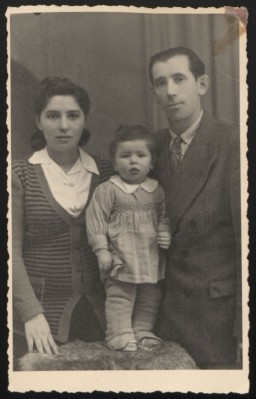
Portrait of the Ehrlich family seated around the family table. Munkacs, Czechoslovakia, 1930. Among those pictured is Elizabeth Ehrlich (later Roth) standing in the middle of the back row in a light dress, and Rella Ehrlich (front row, second from the right). Elizabeth was born in Munkacs. In 1944 she was confined to the ghetto there before being deported with her family to Auschwitz. She was later transferred to a camp in Bydogszcz, Poland, and from there to the Stutthof concentration camp.
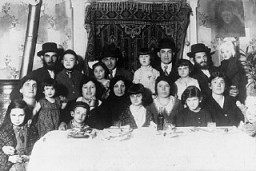
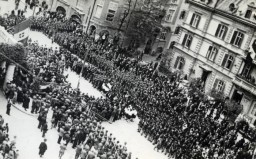
A young girl in a home for Jewish infants waiting for their families to claim them or be adopted. Etterbeek, Belgium, after 1945.
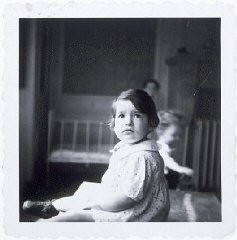
Jewish refugees in Shanghai look for names of relatives and friends who may have survived the war. Awaiting repatriation, these displaced persons were under United Nations Relief and Rehabilitation Administration care. China, 1946.
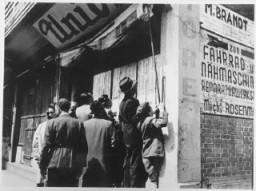
Father Charles Coughlin, leader of the antisemitic Christian Front, delivers a radio broadcast. United States, February 4, 1940.
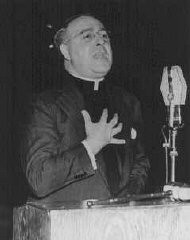
Father Wlodarczyk attempts to clean and repair a bombed-out church in the besieged city of Warsaw. Photographed by Julien Bryan, Warsaw, Poland, ca. 1939.
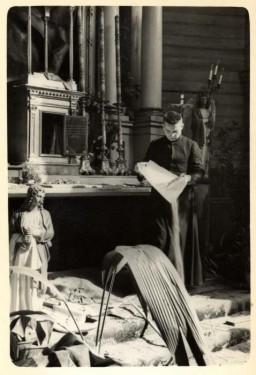
A group of female performers from the German Africa show (Deutsche Afrika-Schau) sitting on a circus wagon. This photo was likely taken in Eisleben, Saxony-Anhalt, Germany, around 1936-1937. Though early ethnographic shows like the Deutsche Afrika-Schau were exploitative by nature, artists originally had the ability to shape their own performances and how they were represented. After the Nazis came to power in 1933, this agency began to disappear. During the Nazi era, working in such shows was an…
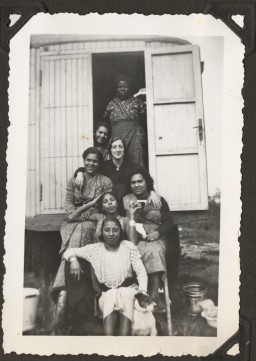
Soldiers of the Polish Home Army Women's Auxiliary Services, taken captive by the Germans in October 1944 as a result of the Warsaw Polish uprising. After the uprising ended on October 2, the Germans took as prisoners of war more than 11,000 soldiers of the Polish Home Army.

Members of the Chug Ivri (Hebrew Club) in Berlin enjoy a festive meal in celebration of Purim. Berlin, Germany, 1935.
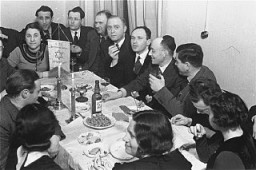
Mortar men of the 754th Tank Battalion fire an 81mm mortar at German positions during the heavy fighting in the Hürtgen Forest. December 15, 1944. US Army Signal Corps photograph taken by C. Tesser.

US Marines head for the front lines in the jungles of Bougainville, one of the Solomon Islands in the Pacific Ocean. 1943.
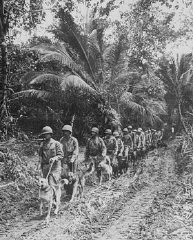
Film evidence is shown during the trial of Adolf Eichmann. Jerusalem, Israel, June 8, 1961.
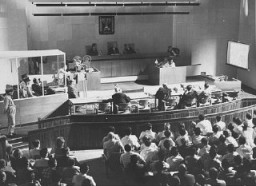
Former mayor of New York Fiorello H. La Guardia, on a tour of United Nations Relief and Rehabilitation Administration (UNRRA) camps in Europe, speaks to survivors. Duppel displaced persons camp. Germany, August 20, 1946.
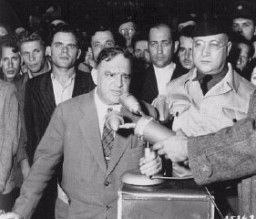
Fire brigade arrives at the Reichstag (German parliament) building. Despite fire-fighting efforts, the building was virtually destroyed by fires set at several places in the building. Berlin, Germany, February 27, 1933.

Firemen in the Reichstag (German parliament) building after it was damaged by arson. Berlin, Germany, February 27, 1933.
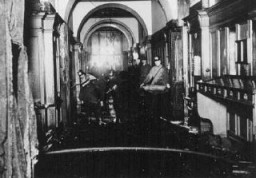
Two Jewish girls (cousins Margot and Lotte Cassel) ready for their first day of school in Breslau, Germany, ca. 1937. As was traditional for all children in Germany, the cones were filled with treats to celebrate their first day of school. Margot's father, Saul, worked in the Tietz department store until he was dismissed following the enactment of the Nuremberg Laws.
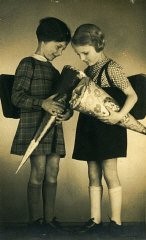
Berta Rosenheim poses with a large cone, traditionally filled with sweets and stationery, on her first day of school. Leipzig, Germany, April 1929.
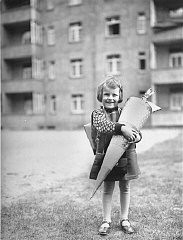
Portrait of five-year-old Mania Halef, a Jewish child, who was later killed during the mass execution at Babi Yar.
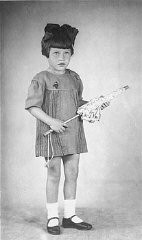
A digital representation of the United States 101st Airborne Division's flag. The US 101st Airborne Division (the "Screaming Eagles" division) was established in 1942. During World War II, they were involved in D-Day and the Battle of the Bulge. The division also captured the city of Eindhoven and uncovered the Kaufering IV camp. The 101st Airborne Division was recognized as a liberating unit in 1988 by the United States Army Center of Military History and the United States Holocaust Memorial Museum…
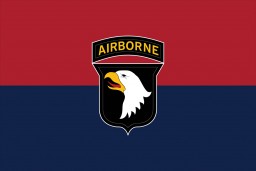
A digital representation of the United States 103rd Infantry Division flag. The US 103rd Infantry Division (the "Cactus" division) was established in 1942. During World War II, they were involved in the Battle of the Bulge and captured the city of Innsbruck. The division also uncovered a Nazi subcamp attached to Kaufering camp complex. The 103rd Infantry Division was recognized as a liberating unit in 1985 by the US Army's Center of Military History and the United States Holocaust Memorial Museum…

A digital representation of the United States 104th Infantry Division's flag. The US 104th Infantry Division (the "Timberwolf" division) was activated in 1942. During World War II, they captured the cities of Cologne and Halle. The division also overran Nordhausen and the Dora-Mittelbau concentration camp. The 104th Infantry Division was recognized as a liberating unit in 1988 by the United States Army Center of Military History and the United States Holocaust Memorial Museum (USHMM).
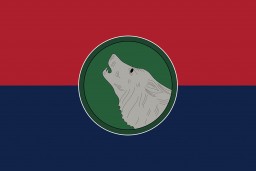
A digital representation of the United States 10th Armored Division's flag. The US 10th Armored Division is also known as the "Tiger" division. During World War II, they captured the cities of Trier and Oberammergau. The division also overran a Dachau subcamp. The 10th Armored Division was recognized as a liberating unit in 1985 by the United States Army Center of Military History and the United States Holocaust Memorial Museum (USHMM).
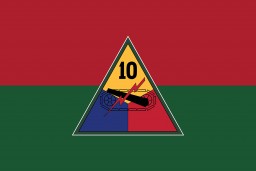
A digital representation of the United States 11th Armored Division's flag. The US 11th Armored Division (the "Thunderbolt" division) was formed in 1942. During World War II, they were involved in the Battle of the Bulge and captured the cities of Coburg, Bayreuth, and Linz. The division also overran the Mauthausen and Gusen concentration camps. The 11th Armored Division was recognized as a liberating unit in 1985 by the United States Army Center of Military History and the United States Holocaust…
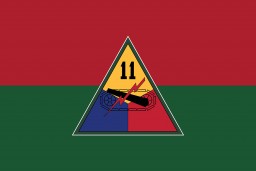
A digital representation of the United States 12th Armored Division's flag. The US 12th Armored Divison is also known as the "Hellcats" division. During World War II, they captured the cities of Ludwigshafen and Würzburg. The division also overran a subcamp of Dachau. The 12th Armored Division was recognized as a liberating unit in 1988 by the United States Army Center of Military History and the United States Holocaust Memorial Museum (USHMM).
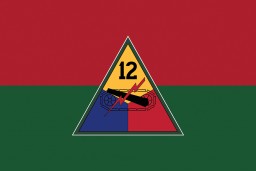
We would like to thank Crown Family Philanthropies, Abe and Ida Cooper Foundation, the Claims Conference, EVZ, and BMF for supporting the ongoing work to create content and resources for the Holocaust Encyclopedia. View the list of donor acknowledgement.